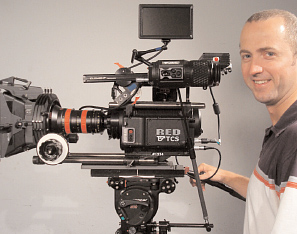No Shortcuts for These Videographers
SEATTLE
Video camera lenses are like a lot of pieces of video equipment: there’s “good-enough,” and there’s top-of-the-line. And while the vast preponderance of video lens purchasers may walk away with a lens that will get them by, some lens user step up to the plate, open their wallets and buy the best there is.

Bob Poole Bob Poole shoots a lot of nature materials, and is doing a lot of work currently for National Geographic Channel. His work all over the African continent has dictated he use a very long HD zoom lens.
“Filming things like elephants and gorillas, they’re animals that you can’t get close to when they’re really in the wild,” he said. “Those animals are very cautious, and for situations like that a long lens like I have is very useful.”
Poole uses a Fujinon HA25X16.5BERD zoom which tops out its zoom at 413mm before the 2x extender is engaged. He noted that there really are no “inexpensive” really long HD zoom lenses. For scenic vista shots and moving shots, on a Steadicam or cable rig, he also owns a Fujinon HA13X4.5BERM.
“The clients that I work for, they expect you’re going to provide the best you can get, that’s sort of expected,” he said. He noted some companies specify different levels of HD quality for different projects.
“A certain project will require a ‘gold-standard’ camera and lens—that means you’re not going to get away with using an inexpensive camera. I’m only working on projects that require that gold standard stuff.” He has long shot with a Sony F900 camera, and has added a Sony PDW-700 XDCAM camcorder.
Poole added one final reason for stepping up to the best of lens gear: durability. The very nature of his assignments means a lot of banging around. “Every once in a while something will get dropped, and you’ll go ‘Oh no!’ But when you pick it up it’s still in one piece.”
ONE MAN BAND
Where Bob Poole relies on a long zoom lens to capture his subjects, Mark Anderson uses a top-of-the-line lens for its performance at the wide end of the zoom range.
Anderson, who cut his teeth shooting news at a network affiliate, now produces stories for programs such as “Northwest Indian News” as a one-man-band. “One of the most important things in my stories is the interviews. When I worked at a station, I had a reporter hold the mic and ask questions, but now I have to do that in addition to shooting.”
A number of years ago, Anderson discovered the Canon HJ 21x7.6B zoom, “a top-of-the-line lens, without being an ultra-wide lens that would also start bending architecture-wise.” He added a Schneider .8 wide angle converter, which holds focus through the zoom and still doesn’t bend the lines at the wide end.
“Now I can zoom wide, frame up my interview subject, then move around in front of the camera and do the interview.” On his Panasonic AG-HPX500 camera he can flip the LCD monitor around and glance at it to check the framing.

Erik Scheitinger Anderson likes working with a lens combination that gives him that wide an angle. “It really gives you what you’re looking at with your eyes. Your eyes see wider than a normal lens at wide angle, but this lens combination has really given me a signature look to all my stories that I produce, as well as commercials and corporate work that I do.”
“It’s the best lens I could possibly get,” he said, “because in this day and age of HD production work, you want the best possible piece of glass on the front of your camera, because image is everything.”
HITTING THE MARK
Where Poole and Anderson are owner/operators of their equipment, New York City’s TCS (Technological Cinevideo Services), a digital and motion picture camera rental house, also saw the advantage of providing top-of-the-line lenses to their clients.
TCS added a pair of Thales Angenieux Optimo Rouge zoom lenses to their inventory that together cover the zoom range from 16 to 80mm.
TCS managing partner Erik Schietinger said the Angenieux Optimo brand’s reputation preceded the Rouge product line. “By the time the Rouge series was introduced, customers knew if it said Optimo on it, it was a good product.”
The two Rouge zooms combine very high quality lenses with a wide aperature (T2.8) and light weight, which makes them portable and convenient for use in handheld, Steadicam or studio configurations. Image quality was still a top consideration.
“We did comparisons on the lens projector and also calibrated the lenses to make sure they hit the mark,” said Schietinger. “Finally, we put them up on our 35mm digital sensor cameras such as the Sony F35, the Phantom and the RED ONE to see how they looked on a camera. In all situations, we were very happy with the way the Rouge lenses project and how they fit into our zoom lens category.”
In HD video lenses, there will always be good-enough, and then a reason to pay more and get more.
Get the TV Tech Newsletter
The professional video industry's #1 source for news, trends and product and tech information. Sign up below.
